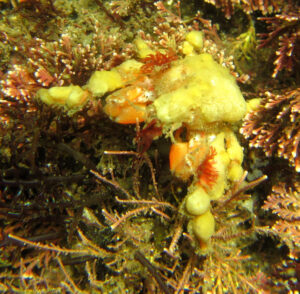Dwarf Teardrop Crab, Pelia tumida

 Dwarf Teardrop Crab, Pelia tunida. Underwater photograph taken in Mission Bay, San Diego, California, July 2020. Photograph and identification courtesy of Bob Hillis, Ivins, Utah.
Dwarf Teardrop Crab, Pelia tunida. Underwater photograph taken in Mission Bay, San Diego, California, July 2020. Photograph and identification courtesy of Bob Hillis, Ivins, Utah.
General information: The Dwarf Teardrop Crab, Pelia tumida (Lockington, 1877), is a brachyuran crab and a member of the Epialthidae Family of Spider Crabs. Worldwide, there are five species in the Genus Celia, of which two species are found along Mexico’s Pacific coast. The Dwarf Treadrop Crab is poorly studied with very limited information available about their lifestyle and behavioral patterns including specific details on age, growth, longevity, movement patterns, diet, habitat use, and reproduction.
Identification: The Dwarf Teardrop Crab has a pear-shaped shell that has a smooth texture and is covered with short hairs. They are dimorphic with males having bright orange-red claws. They have front legs that extend forward and curve outward at the last two segments. They are often covered with sponges or other encrusting life forms as a form of camouflage or in order to make itself distasteful to predators. They are small in stature and have shells that have a maximum width of 1.5 cm (0.6 inches).
Habitat and Range: The Dwarf Teardrop Crab is found in all Mexican waters, including the Sea of Cortez, of the Pacific Ocean with the exception that they are absent from waters south of Petatlan, Guerrero. They are found on, and under, rocks, cobbles, and kelp holdfasts, and reside in the low intertidal zone to depths up to 128 m (420 feet).
Diet: The Dwarf Teardrop Crab is an omnivorous scavenger. They consume algae and carrion (deceased animals).
Conservation Status: From a conservation perspective the Dwarf Teardrop Crab has not been formally evaluated. However, they are common and of limited interest to most and should be considered to be of Least Concern.
Synonyms: Pelia clausa, Pisoides tumidus, and Microphrys tenuidus